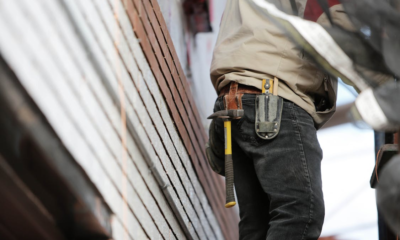Home Decor
Evolution Of Restaurant Table Top
Published
11 months agoon

Restaurants always work to give their customers an exceptional and unforgettable dining experience in the culinary business’s vibrant and constantly changing world. In addition to delicious food and excellent service, a restaurant’s atmosphere and aesthetics are vital in influencing patron views and forging lifelong memories. The tabletop is one element of restaurant design that is sometimes disregarded yet significantly influences the whole thing. Restaurant table tops have seen a remarkable transition throughout time, fusing technology, design, and practicality to produce an engaging eating experience.
AESTHETIC APPEAL AND AMBIENCE
Restaurant tabletops have come a long way from the early days when dining areas were furnished with plain hardwood tables. These tables were functional in design, fulfilling the primary function of giving diners a surface on which to set their plates and cutlery. But as the culinary world advanced, so did consumer expectations.
Restaurant owners realized that tabletops might be used as a blank canvas to improve the mood of the eating area. The use of numerous materials, like marble, granite, glass, and even salvaged wood, gave restaurant design a variety of textures and hues. These elements not only gave the institution a bit of refinement but also helped develop specific themes and moods.
There has been a renaissance of interest in minimalist design in recent years. Smooth materials, subdued colors, and clean lines are now in demand. While matte surfaces create a more muted and relaxing ambiance, high-gloss finishes offer a contemporary and polished appearance. Restaurants may generate feelings and provide a memorable eating experience by carefully selecting their tabletop aesthetics.
FUNCTIONALITY AND DESIGN INTEGRATION
Restaurant tabletops have evolved, and practicality has become as important as aesthetics. Tabletop design has emerged as an area for innovation as restaurants seek to streamline their processes and increase efficiency.
One exciting development is the incorporation of wireless charging and charging stations onto tabletops. Offering diners a simple method to stay connected has evolved into a competitive advantage as smartphones and other electronic devices grow. These integrated charging solutions do away with unattractive wires and adapters by blending into tabletops.
Additionally, tabletops have changed in size and form to accommodate various dining tastes. Long communal tables provide a sense of community, whereas circular tables encourage communal meals and enable interaction. More diminutive, square dining tables provide a cozy atmosphere for exclusive eating occasions.
CULINARY COMMUNICATION THROUGH TABLE TOPS
Tabletops in restaurants now serve more purposes than just storing tools and plates. They now act as a means of communication between cooks and guests over food. One novel way is using tabletop visuals to explain the provenance of materials, cooking methods, and the chef’s motivation behind each meal. By providing insights into the culinary journey and cultivating a greater appreciation for the creativity behind the food, this immersive narrative enriches the eating experience.
Additionally, elite eating venues are using digital tabletops. By selecting food, altering portion sizes, and even obtaining wine-matching recommendations, these interactive surfaces let customers personalize their dining experiences. These technologically-based improvements give patrons more control and make them active participants in their eating experience.
SUSTAINABILITY AND ECO-FRIENDLY SHIFT
The selection of restaurant tabletops’ materials has gained attention during increased environmental awareness. Tabletop design is evolving to align with eco-friendly practices as the restaurant business accepts its role in sustainability.
Reclaimed wood, taken from old buildings or other sources and reused, is becoming increasingly well-liked as a sustainable tabletop material. Its aged look gives room for character while lowering the need for newly harvested wood. Additionally, composite materials created from recycled glass, paper, or plastic are making their way into the tabletops of restaurants, fostering the circular economy and lowering the carbon footprint of eating places.
Recent News


4 Amazing Trips for Your Family
Choosing somewhere for a family vacation that would pique the attention of adults and kids alike can be a fun...


Customising Your Makeup with Blendable Blush Options
In cosmetics, one’s face is a canvas for self-expression and creativity. Among the myriad of products available, blush is a...


The Benefits of Regular Home Maintenance
Regular home maintenance is essential for maintaining and even raising the value of your house. A proactive approach to repairs...


Understanding the Importance of SEO in Adelaide
In the digital marketplace, Adelaide businesses are in a continuous contest to gain the attention of their target audiences. With...


Breaking Down the Numbers: Understanding the Average Traveling Nurses Pay
The open road, adventure, and the chance to heal – travel nursing promises an undeniable allure. But amidst the excitement,...


Dealing with Oily Skin in Summer: Tips and Tricks
As the temperature rises, those with oily skin often face an additional challenge—maintaining a clear and balanced complexion. Excess oil...


Mountain Wedding Ideas for 2024
A mountain wedding is a stunning choice for couples who cherish nature and desire a distinctive wedding experience. Whether you...


3 Of The Best Ways To Keep Your Salon Clean
It is of the utmost importance to ensure that a salon is kept scrupulously clean, not just for the sake...


3 Reasons You Should Get Blood Tests Every Year
Regular blood tests are essential for preserving general health and identifying potential problems early on. Medical professionals can evaluate your...


How to Make Your Next Crafts Project Pop
Crafting is a creative outlet that allows individuals to express themselves through various mediums such as paper crafts, sewing, painting,...
